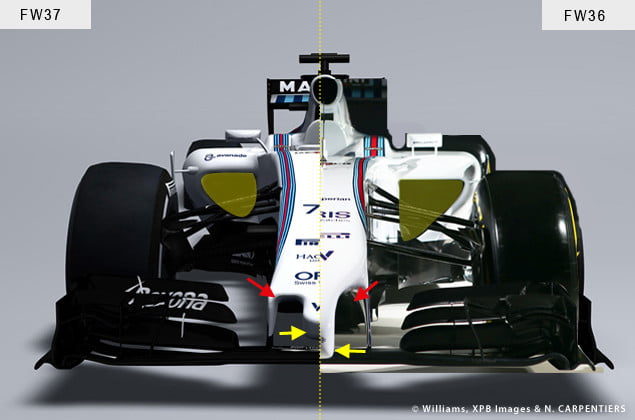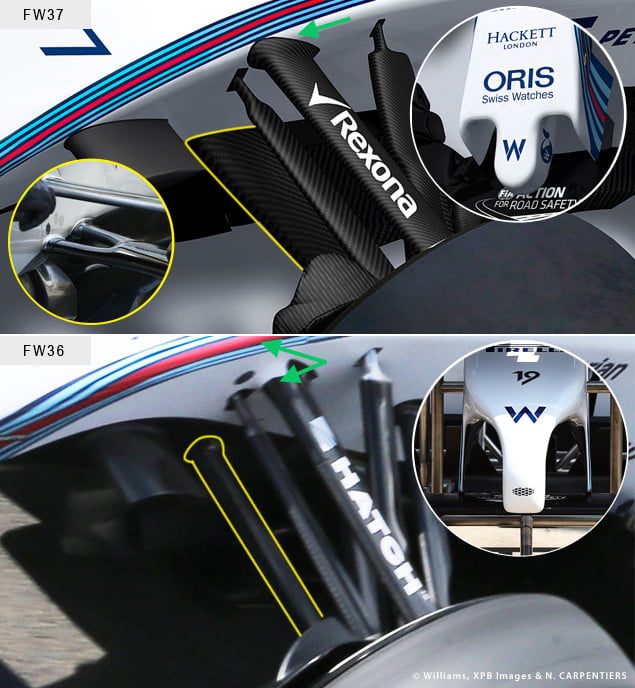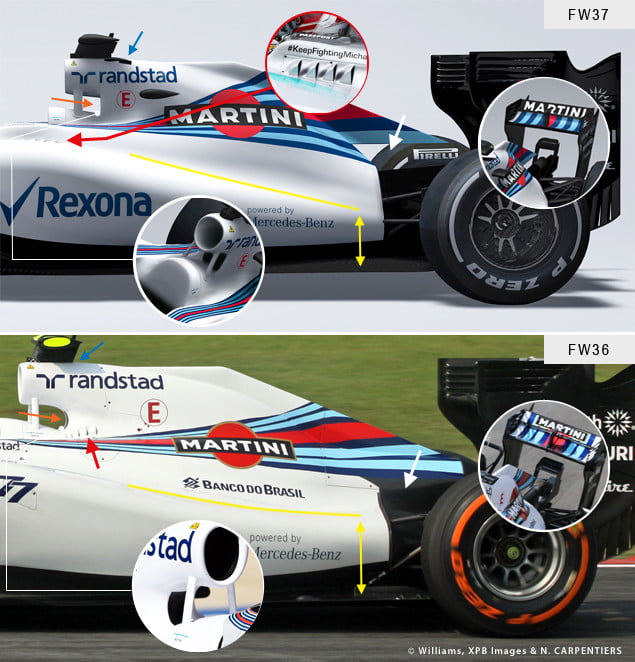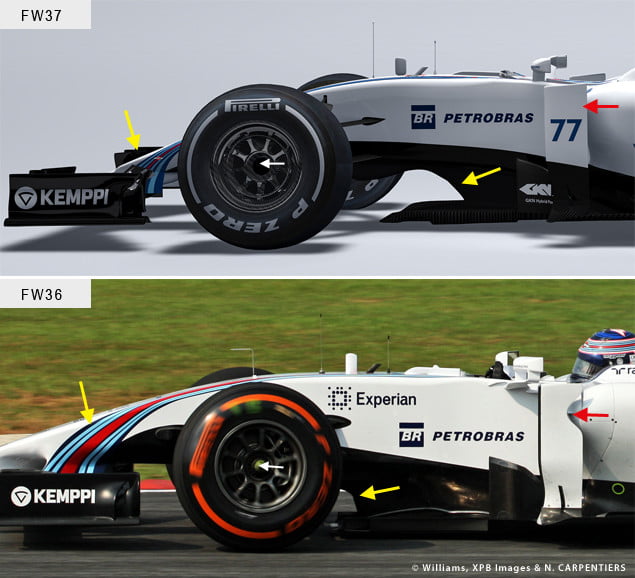After Williams released the first rendered images of their 2015 car last Wednesday there was no denying that the new FW37 clearly appeared as an evolution of Grove’s previous challenger. Of course, one must remain cautious when it comes to computer-generated illustrations, as these do not always reflect reality (remember when Mercedes eventually disclosed actual pictures of its hybrid turbo V6 last October?). Still, Williams pretty much did the same in early 2014 when they began to lift the veil on their FW36 by issuing pre-launch renderings. And these already offered a good insight into the car’s eventual design.
This undoubtedly boded well for the British team, as their 2014 contender proved to be a thoroughbred car and the second best machine on the grid last year. Indeed, compared to Mercedes’ all-conquering W05, the FW36’s deficit reached 0,85% – or around 0.747s per lap –, while Red Bull’s RB10 was further adrift with an average deficit of 0.96%.
Now that F1 teams have had a full season to get to grips with the new radical hybrid power units, they’ve been able to focus on gaining performance and streamlining the overall engine package over the winter break. Williams’ latest machine looks more nimble and sophisticated than last year’s car, while also featuring a new nose that complies with the 2015 technical regulations (potential hyperlink to the “nose” article). The smaller, thumb-like tip has been designed with a view to restrict airflow blockage as much as possible.
As shown above, the 2015-spec nose is mostly wider, which in turn makes for a smaller airflow inlet (cf red arrows). This will limit the amount of air that can get sucked under the bodywork and consequently increase the car’s ground effect. Its sidepods seem to be more compact, although this remains difficult to gauge due to both images having different angles.
STREAMLINING THE DESIGN
Despite the FIA’s best efforts to deter F1 teams from coming up with ungainly front designs, the FW37’s nosecone does feature the now infamous “anteater” concept, albeit with a more square-edged tip. The latter forms a keel base that tapers under the front wing. The overall chassis slope looks quite bulky around the tip (in order to meet the new technical requirements), before narrowing upwards towards the cockpit.
The FW37’s lower suspension arm is much flatter and slimmer than on its predecessor (see the yellow outlines below). Therefore, it looks as though Williams’ engineers did not copy the conjoined wishbone approach that Mercedes used on its Silver Arrows last year (as per the yellow circle).
Early rumors report that Mercedes’ 2015 overall V6 package would significantly differ from its predecessor.
As for the upper suspension arm, where you can spot Rexona branding after Williams “nicked” it from Lotus, it has been mounted as high as possible and is almost level with the top of the nosecone. The overall package may exude agility, if not aggressiveness, although this remains an educated guess, at least until February 1st when winter testing gets underway in Jerez, Spain.
Williams is likely to have poured a lot of efforts into the rear of their new contender. Compared to last year’s title-winning W05, the FW36 was indeed lacking downforce in slow and mid speed corners, a feature that was noticeable at Yas Marina for instance. As seen below, the opening located under the air intake has similar dimensions to that of last year, and probably aims at cooling the ERS down. However, Williams seems to have taken inspiration from Mercedes to design their new cooling gills (see red arrows).
STILL NO CENTRAL SUPPORT PILLAR
Despite some key aero parts probably still missing and the presence of 2014-spec wings, these computer renderings do show that the Grove-based team has retained the same aero concept with minor tweaks on the car’s flanks and sidepods. The latter seem to drop at a lower level (see yellow curved lines), while also featuring a sponsor logo for the first time since 2010. With the bodywork wrapping up even more compactly around the engine cover, this means that Williams has kept their own gearbox. Early rumors report that Mercedes’ 2015 overall V6 package would significantly differ from its predecessor as the Brixworth engineers apparently made the most of the opportunity to alter 48% of the unit. If the latest German power plant proves to be even more competitive in 2015, customer team Williams looks primed to take full advantage of it.
Only time and future under-skin images of the FW37 will tell if Pat Symonds and his team have indeed copied Mercedes’ unique intercooler installation, which is placed right behind the driver’s head. The system helps clear the sidepod inlets as much as possible, which in turn reduces internal airflow resistance.
Unlike all the other F1 teams, Williams once again elected to carry on not using a central pillar to support their rear wing assembly. The rationale behind it is that such a design decreases aero drag – this would explain the FW36’s healthy top speed and low fuel usage –, while also improving cooling as hot air can be evacuated more easily. Some observers also believe that the absence of a pillar has to do with aeroelasticity, which can be used to deform the rear wing installation and reduce drag as a consequence.
While the first actual on-track pictures of the FW37 should offer a more accurate insight into its overall package, Williams seems to have built an optimized and more aggressive version of their 2014 car. This pragmatic approach is something of a Pat Symonds trademark. After being quite inconsistent over the last few years, the British squad can now rely on their chief technical officer to lay solid foundations and build on its 2014 resurgence. Given their pace at the end of last year, Williams should also benefit from F1 technical regulations being mainly unchanged in 2015. It just remains to be seen whether Grove will receive power unit updates at the same rate as the Mercedes works team.
Click here to see the full gallery of the first Williams FW37 images










